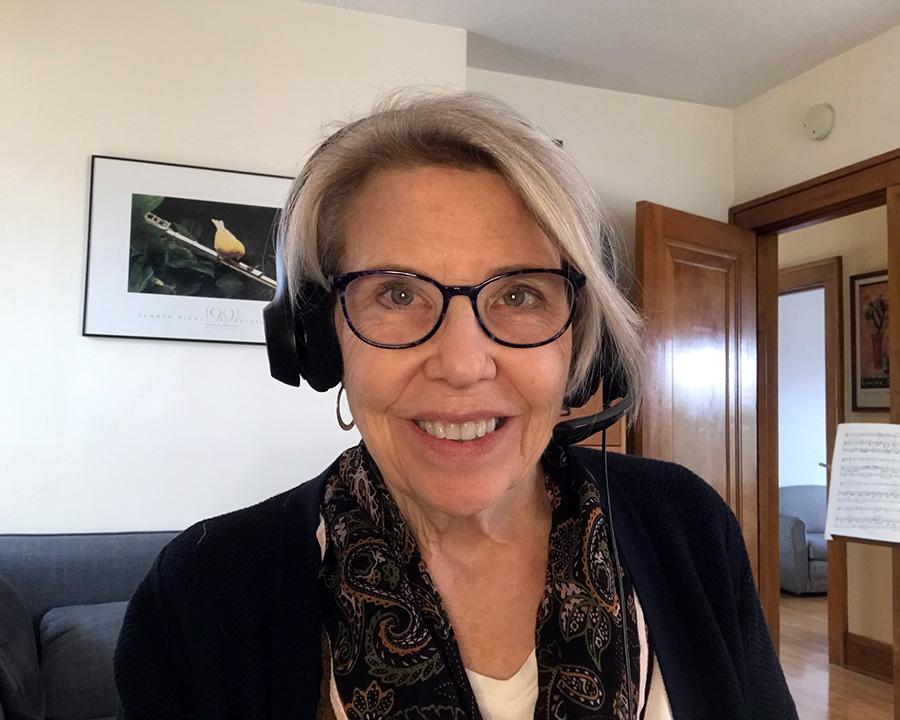Singing in a virtual space
Spring is often the busiest time for the Minneapolis College Choir. But last spring, everything changed. As the world shut down in the wake of the COVID-19 pandemic, Minneapolis College Choir members saw their once full calendars empty almost overnight — no concerts, no school visits, no live performances.

As the shutdown continued, Minneapolis College Choir Director Liz Pauly struggled to find ways to create meaningful musical experiences for the choir members in the new virtual world.
“COVID hit the music community especially hard. All the performing venues shut down. What few performance opportunities there were limited to small groups, and of course, masked. Performers had to make a quick transition from the traditional live performance to pre-recorded and live-streamed events,” Pauly said.
The work paid off in two innovative collaborations:
- A continued partnership with the Minnesota Chorale, the principal chorus of the Minnesota Orchestra. In place of live concerts, the Chorale has worked with Minneapolis College to provide resources such as music and guest artists, has invited students to drop into Chorale rehearsals and has welcomed the Minneapolis College Choir to perform with them in virtual concerts including a performance on March 29.
- A consortium of choirs from the two-year colleges in the state system have joined to share resources and create a virtual choir. Programs at Minneapolis College, North Hennepin, Anoka-Ramsey’s two campuses, Fergus Falls, Normandale and Riverland will host a viewing party March 24 celebrating the release of the collaborative virtual choir.

Shaniece Pink and Molly Sullivan are second-semester music students taking on the challenge of choral singing in a virtual space.
“Regardless of what is going on in the world, I want to be involved in music,” said Pink, who has been performing since she was 10 in gospel choirs. “I went to develop studying music therapy and medical ethno-musicology … to create music that will be a part of healing my people, my community, especially as a black woman.”
Pink and Sullivan want to transfer to four-year colleges after completing their Minneapolis College music education.
“My background in the performing arts started when I was four,” said Sullivan. “I was in dance 10 years, ballet, tap and Irish that led me into musical theater. I went to the St. Paul Conservatory for Performing Artists for high school, took voice lessons and sang in a band outside school. I want a degree in music and Minneapolis College offered me a way to start on this path.”
Pink and Sullivan found an entirely new method of approaching music under Pauly’s direction.
“We learn a song and edit it together, virtually,” Sullivan said. “Most of us have never really done choir that way before. We’re not only performing with the Minneapolis College choir, but the other community college choirs are coming together to form a super choir.”
“We’re experiencing music in an entirely different way,” said Pink. “We’re like low key producers now. I am using technology I never used before, like Soundtrap and Songalong. At first, it’s overwhelming. But, you know what — this is a skill I am going to need to use anyway. I always said I would love to produce my own music.”
“Fast forward — here we are,” Pink said. “Now, I am splicing my voice on different tracks and adding it with others. I can’t imagine what’s involved on the other end with Liz and Minnesota Chorale and all the other voices. It’s not something we planned, but I know how to use Soundtrap now and I’m looking at other programs to put my own songs together.”
The virtual aspect resulted in unexpected benefits, such as accepting new challenges and gaining confidence. “It forced me to step to the plate,” Pink said. “I started taking piano lessons and I feel comfortable in my own environment.”
Sullivan adds, “The pandemic forced me to evaluate my needs. I really see what I want to do, whether I am producing music or performing.”
Pauly, a member of the Minneapolis College music faculty since 1997, finds her students a constant source of inspiration. “They just want to sing — they’re dying for an artistic outlet. And they want to connect with people.”
